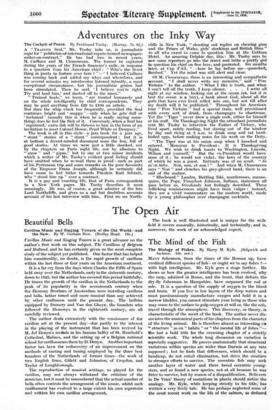The Mind of the Fish
May fishermen, from the times of the Roman up, have credited different Species OT`fish=or Ought we to say fishes 9— with high intelligence. 'kyle" goes a stage further. He shows us how the greater- intelligence has been -evolved, why the carp, addiired iii Rome, and the trout, that defeats the dry-fly fishernian in Hampshire, have surpassed the cod . or sole: It is a question of the supply of oxygen to the blood and brain. • If you live' in low layers of the' deep Waters and must parsimoniously manufacture oxygen and hold it in a narrow bladder, you cannot stimulate your being as those .Who may come to the surface to gulp oxygen at will or, like the eels, travel' through the atmosphete. This discovery, or theory,' is characteristic of the merit of the book. The author never dis- sociates the anatomical parts of his chapters from the character of the living animal. He is therefore almost-as interesting -on structure "as on " habits " or" the mental life of fishes "- the last a bold title for the crowning Chapter of a strictly scientific work.' The whole long discussion on variation is especially suggestive. He proves anatomically that-structural variations within species are wider than Darwin at any rite supposed ; but he finds that differences, which should be a handicap, do not entail elimination, but 'drive the creature to stronger efforts to survive. The eccentric fish - may- seek another layer of water and there breed eccentric young- sters, and so found a new species, not at all because he was fitter' to survive; but by reaSen of a disqualification. Believeri in De Vries' theory of mutations in plants should notice the analogy. Mr. Kyle, while keeping strictly to his title, has Written a very liirer3r tale. He has perhaps neglected some of the most- recent work on the life of the salmon, as deduced from the study of scales, but in general his account of migra- tion, with its causes and effects, is an excellent epitome of recent knowledge. A good example is the analysis of J. Schmidt's amazing discoveries about the breeding of the European—and American—eels in mid-Atlantic. The volume 4,3 a worthy companion to the fascinating Biology ,of Birds by Professor Thomson in the same series.























































 Previous page
Previous page